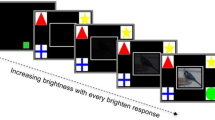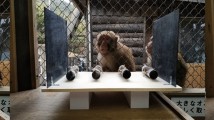Abstract
Rhesus monkeys are known to recognize confidence about their immediate perceptual and cognitive decisions by using a betting procedure (Son and Kornell in The missing link in cognition: origins of self-reflective consciousness. Oxford University Press, New York, pp 296–320, 2005; Kornell et al. in Psychol Sci 18:64–71, 2007). In this report, we examined whether this ability is shared in two avian species (pigeons and bantams) in order to know how widespread this metacognitive ability is among animals. We trained pigeons and bantams to search for a differently colored disk (target) among others (distracters) displayed on a touch-sensitive monitor. In test, the subjects were required to choose one of two confidence icons, “risk” and “safe”, after the visual search. A peck at the “risk” icon after a correct response in the visual search (i.e., a peck at the target) was reinforced by food and light, while that after an incorrect response (i.e., a peck at a distracter) resulted in a timeout. A peck at the “safe” icon was always reinforced by food and light, or by light only, regardless of the visual search result. The percentages of “safe” choices after incorrect responses were higher than after correct responses in all six pigeons and two of three bantams. This behavior generalized to novel stimuli in some subjects, and even to a novel line-classification task in a pigeon. These results suggest that these two distantly related avian species have in common a metacognitive ability that allows them to recognize confidence about their immediate perceptual decisions.







Similar content being viewed by others
Notes
In a previous study in orangutans, it took a relatively small number of trials for training (Suda-King 2008). In the present study, many hundreds of training trials were required before testing the same as previous studies in rhesus monkeys (Smith et al. 1995; Hampton 2001; Kornell et al. 2007). It may be due to task differences.
References
Beran MJ, Smith JD, Redford JS, Washburn DA (2006) Rhesus macaques (Macaca mulatta) monitor uncertainty during numerosity judgments. J Exp Psychol Anim Behav Process 32:111–119
Fujita K (2009) Metamemory in tufted capuchin monkeys (Cebus apella). Anim Cogn 12:575–585
Fujita K, Ushitani T (2005) Better living by not completing: a wonderful peculiarity of pigeon vision? Behav Processes 69:59–66
Hampton RR (2001) Rhesus monkeys know when they remember. Proc Natl Acad Sci USA 98:5359–5362
Inman A, Shettleworth SJ (1999) Detecting metamemory in nonverbal subjects: a test with pigeons. J Exp Psychol Anim Behav Process 25:389–395
Kornell N, Son LK, Terrace HS (2007) Transfer of metacognitive skills and hint seeking in monkeys. Psychol Sci 18:64–71
Nakamura N, Fujita K, Ushitani T, Miyata H (2006) Perception of the standard and the reversed Müller-Lyer figures in pigeons (Columba livia) and humans (Homo sapiens). J Comp Psychol 120:252–261
Nakamura N, Watanabe S, Fujita K (2008) Pigeons perceive the Ebbinghaus-Titchener circles as an assimilation illusion. J Exp Psychol Anim Behav Process 34:375–387
Nakamura N, Watanabe S, Fujita K (2009a) Further analysis of perception of reversed Müller-Lyer figures for pigeons (Columba livia). Percept Mot Skills 108:239–250
Nakamura N, Watanabe S, Fujita K (2009b) Further analysis of perception of the standard Müller-Lyer figures in pigeons (Columba livia) and humans (Homo sapiens): effects of length of brackets. J Comp Psychol 123:287–294
Nakamura N, Watanabe S, Betsuyaku T, Fujita K (in press) Do bantams (Gallus gallus domesticus) experience amodal completion? An analysis of visual search performance. J Comp Psychol
Nelson TO, Narens L (1990) Metamemory: a theoretical framework and new findings. Psychol Learn Motiv 26:125–173
Raby CR, Alexis DM, Dickinson A, Clayton NS (2007) Planning for the future by western scrub-jays. Nature 445:919–921
Roberts WA, Feeney MC, McMillan N, MacPherson K, Musolino E, Petter M (2009) Do pigeons (Columba livia) study for a test? J Exp Psychol Anim Behav Process 35:129–142
Smith JD, Schull J, Strote J, McGee K, Egnor R, Erb L (1995) The uncertain response in the bottlenosed dolphin (Tursiops truncatus). J Exp Psychol Gen 124:391–408
Smith JD, Shields WE, Schull J, Washburn DA (1997) The uncertain response in humans and animals. Cognition 62:75–97
Smith J, Redford J, Beran M, Washburn DA (2010) Rhesus monkeys (Macaca mulatta) adaptively monitor uncertainty while multi-tasking. Anim Cogn 13:93–101
Sole LM, Shettleworth SJ, Bennett PJ (2003) Uncertainty in pigeons. Psychon Bull Rev 10:738–745
Son LK, Kornell N (2005) Metacognitive judgments in rhesus macaques: Explicit versus implicit mechanisms. In: Terrace H, Metcalfe J (eds) The missing link in cognition: origins of self-reflective consciousness. Oxford University Press, New York, pp 296–320
Suda-King C (2008) Do orangutans (Pongo pygmaeus) know when they do not remember? Anim Cogn 11:21–42
Sutton JE, Shettleworth SJ (2008) Memory without awareness: pigeons do not show metamemory in delayed matching to sample. J Exp Psychol Anim Behav Process 34:266–282
Terrace HS, Son LK (2009) Comparative metacognition. Curr Opin Neurobiol 19:67–74
Acknowledgments
This work was supported by the JSPS Grants-in-Aid for Scientific Research (19-7134, 21-1994 to N. Nakamura; 17300085 and 20220004 to K. Fujita) and the MEXT Global COE Program “Revitalizing Education for Dynamic Hearts and Minds,” D-07 to Kyoto University, Japan. We are grateful to J. R. Anderson, University of Stirling, for careful editing of an earlier version of the manuscript. The care and use of subjects adhered to the guidelines of the Graduate School of Letters, Kyoto University, and the experiment was conducted with the approval of the Animal Experiment Committee of the Graduate School of Letters. The authors declare that they have no conflict of interest.
Author information
Authors and Affiliations
Corresponding author
Rights and permissions
About this article
Cite this article
Nakamura, N., Watanabe, S., Betsuyaku, T. et al. Do birds (pigeons and bantams) know how confident they are of their perceptual decisions?. Anim Cogn 14, 83–93 (2011). https://doi.org/10.1007/s10071-010-0345-6
Received:
Revised:
Accepted:
Published:
Issue Date:
DOI: https://doi.org/10.1007/s10071-010-0345-6




